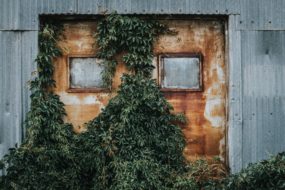Climate Variables and Condensation Control in Metal Buildings
Steel buildings are built tough and designed to last the long haul, but even they have their limitations. When moisture makes its way in unnoticed, it can lead to costly repercussions. Condensation control in metal buildings is one of the surest ways to ward off issues that can eat into a company’s budget — and to extend a structure’s lifespan, too.
In this blog, Metallic Products’ airflow experts will walk you through a few key ways climate or temperature changes can impact moisture levels within your steel buildings, the impacts that moisture can have and steps you can take to keep your structures better protected.

Although inorganic steel is not prone to mold growth, a metal building’s other components can fall victim.
Adequate Airflow Helps Stave Off Mold in Buildings
Mold in buildings is a dangerous thing. Not only can growth bring on questionable smells and stains, but it can have serious health implications, too — especially for people with respiratory issues. In addition, remediation efforts can result in tremendous out-of-pocket costs. Here are some things to keep in mind.
Know the Warning Signs of Mold in Buildings
Unlike tell-tale fuzz on forgotten bread, mold inside a metal building isn’t always readily apparent. This is because it has plenty of places to hide. The first sign of trouble is often an earthy smell or stains around windows, doors, ventilation units and other areas prone to moisture.
Remember, condensation can be mold’s best friend, especially when paired with humid conditions. Does your metal building have a pipe that’s prone to leaks? Does rainwater make its way through weak seams? Do you suspect damp insulation? Pay attention to any areas that might have experienced heightened moisture levels in the past, as mold will swoop in if given the chance.
Know How to Ward Off Future Issues
The bad news is, that mold loves the temperatures that we find most comfortable. The good news is, it thrives on organic matter — and your metal building is inorganic. So, while growth will do damage if left unchecked, it won’t feed on the actual steel that comprises your structure.
We recommend performing regular walk-throughs to spot leaks or corrosion around your metal building, and checking your vents, HVAC units and other building ventilation equipment, too. If you do spot moisture, clean it up. Then, schedule repair work or take other measures to make sure it doesn’t return.
Want to know more? The U.S. Environmental Protection Agency offers detailed information about mold growth, testing, air quality and more.

Rust prevention plays an important role in maintaining your steel building’s strength, aesthetics and value.
Rust Prevention in Steel Structures: The Importance of Letting Buildings Breathe
Rust occurs when iron or alloys are exposed to moisture and oxygen for an extended period. There’s a chemical reaction that takes place, leading to oxidation, corrosion and stains — and because steel is comprised of iron and carbon, it is susceptible to rust formation.
Of course, changes in outdoor temperatures, manufacturing or production process ramp-ups and a slew of other considerations can all affect the condensation levels a steel building is subjected to. And simple oversights can have substantial impacts.
Rust Weakens a Structure
Steel buildings are known for their strength and economic price point, but ignoring rust formation can lead to a weakening of the overall structure. When rust results in corrosion beyond what simple cleaning and patching might allow, it’s often best to replace affected building sections. Of course, the ability to replace individual wall panels — as opposed to entire exteriors — is one of the many benefits associated with pre-engineered metal buildings.
Rust Opens Metal Buildings Up to Moisture Issues
Remember, rust is a form of corrosion. If given the opportunity, it can eat away at your building components, provide new pathways for moisture intrusion and serve as a catalyst for growth of mold and mildew.
Prevent moisture intrusion by keeping your steel buildings clean and trimming back nearby trees so they don’t scratch against the paneling. If you do spot a corroded area, patch it up so water can’t enter. Then, disinfect affected areas with a wire brush and bleach to kill off any mold that may have formed. Be sure to replace any impacted insulation.
Rust Devalues a Metal Building
Whether your metal building serves as shelter for stored items or a workshop for your operations, that structure is a substantial investment. Seeing its worth deflate due to unmanaged corrosion can be discouraging.
Protect your building by conducting routine inspections for rust, and identifying any changes you see. If you spot rust in its early stages, scrub it off with a wire brush and vinegar, as the vinegar will eat away the invading material. Early intervention is imperative.
It’s important for metal building owners to take strategic steps from the very start to keep rust under control. Purchasing quality metal building accessories made of rust-resistant material — or coated to prevent rust from forming — is among the simplest, surest ways to tackle rust prevention.

Building ventilation is just as important during winter months as in summer.
Ventilation in Cold Weather: Healthy, Comfortable Spaces When Temperatures Drop
When people consider the importance of proper ventilation, they often focus on the benefits of releasing summer heat naturally through a building’s vents, louvers and windows. But did you know quality ventilation in cold weather matters just as much?
Consider this. When warm, moist air comes in contact with cold surfaces such as a metal building’s doorways or window frames, its temperature drops below the dew point. And this creates condensation. Buildings where moisture has no place to go find themselves subjected to the moisture issues listed above.
The same metal building accessories that aid in summertime airflow can help keep things healthy and comfortable in the colder months, too. These include:
- Continuous ridge vents perched at the apex of a steel building. They’re available in a range of throat sizes to suit a building’s purpose and airflow needs, and often feature dampers for added control over airflow.
- Gravity ventilators not only remove stale air, but are effective at moving out air contaminated by manufacturing or production processes. In an industrial building, that means cleaner air and enhanced comfort, which is good news for your workers.
- Weather-resistant wall louvers, particularly those specifically designed for pre-engineered metal building wall panels, allow air to flow through while keeping moisture, snow and ice outdoors where they belong.
Seasonal weather patterns, changes to manufacturing or production cycles and similar issues can all impact moisture levels inside your metal buildings. But as long as you understand the potential risks at play — and red flags to watch out for, too — it’s possible to keep your buildings serving you well for decades to come.





